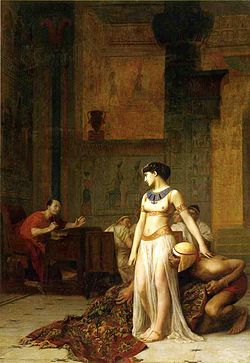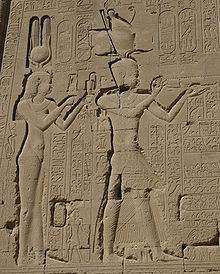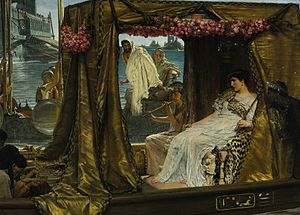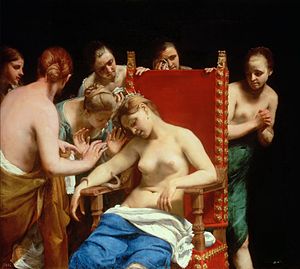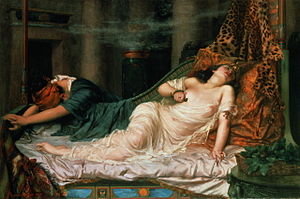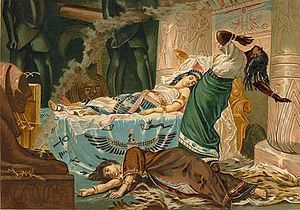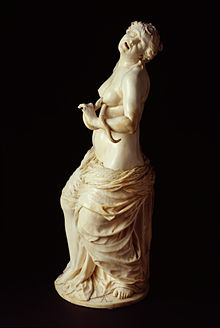
Cleopatra
Background to the schools Wikipedia
SOS Children volunteers helped choose articles and made other curriculum material Click here for more information on SOS Children.
| Cleopatra VII Philopator | |
|---|---|
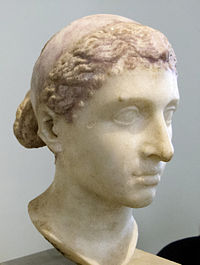 |
|
| Bust of Cleopatra VII, Altes Museum, Berlin | |
|
|
|
| Reign | 51–30 BC |
| Predecessor | Ptolemy XII Auletes |
| Co-rulers | Ptolemy XII Auletes Ptolemy XIII Theos Philopator Ptolemy XIV Ptolemy XV Caesarion |
| Spouse | Ptolemy XIII Theos Philopator Ptolemy XIV Mark Antony |
| Issue | |
| Caesarion, Ptolemy XV Philopator Philometor Caesar Alexander Helios Cleopatra Selene, Queen of Mauretania Ptolemy XVI Philadelphus |
|
| Full name | |
| Cleopatra VII Thea Philopator | |
| Father | Ptolemy XII Auletes |
| Mother | Cleopatra V of Egypt (presumably) |
| Born | 69 BC Alexandria, Egypt |
| Died | 12 August 30 BC (aged 38–39) Alexandria, Egypt |
| Burial | Unknown |
 |
|
| These articles cover Ancient Rome and the fall of the Republic | |
| Mark Antony, Cleopatra VII, Assassination of Julius Caesar, Pompey, Theatre of Pompey, Cicero, First Triumvirate, Roman Forum, Comitium, Rostra, Curia Julia, Curia Hostilia |
Cleopatra VII Philopator (Ancient Greek: Κλεοπάτρα Φιλοπάτωρ; Late 69 BC – August 12, 30 BC), known to history as Cleopatra, was the last pharaoh of Ancient Egypt.
She was a member of the Ptolemaic dynasty, a family of Greek origin that ruled Egypt after Alexander the Great's death during the Hellenistic period. The Ptolemies, throughout their dynasty, spoke Greek and refused to speak Egyptian, which is the reason that Greek as well as Egyptian languages were used on official court documents such as the Rosetta Stone. By contrast, Cleopatra did learn to speak Egyptian and represented herself as the reincarnation of an Egyptian goddess, Isis.
Cleopatra originally ruled jointly with her father, Ptolemy XII Auletes, and later with her brothers, Ptolemy XIII and Ptolemy XIV, whom she married as per Egyptian custom, but eventually she became sole ruler. As pharaoh, she consummated a liaison with Julius Caesar that solidified her grip on the throne. She later elevated her son with Caesar, Caesarion, to co-ruler in name.
After Caesar's assassination in 44 BC, she aligned with Mark Antony in opposition to Caesar's legal heir, Gaius Julius Caesar Octavianus (later known as Augustus). With Antony, she bore the twins Cleopatra Selene II and Alexander Helios, and another son, Ptolemy Philadelphus (her unions with her brothers had produced no children.) After losing the Battle of Actium to Octavian's forces, Antony committed suicide. Cleopatra followed suit, according to tradition killing herself by means of an asp bite on August 12, 30 BC. She was briefly outlived by Caesarion, who was declared pharaoh by his supporters, but soon killed on Octavian's orders. Egypt became the Roman province of Aegyptus.
To this day, Cleopatra remains a popular figure in Western culture. Her legacy survives in numerous works of art and the many dramatizations of her story in literature and other media, including William Shakespeare's tragedy Antony and Cleopatra, Jules Massenet's opera Cléopâtre and the 1963 film Cleopatra. In most depictions, Cleopatra is portrayed as a great beauty, and her successive conquests of the world's most powerful men are taken as proof of her aesthetic and sexual appeal.
Biography
Accession to the throne
The identity of Cleopatra's mother is unknown, but she is generally believed to be Cleopatra V Tryphaena of Egypt, the sister or cousin and wife of Ptolemy XII, or possibly another Ptolemaic family member who was the daughter of Ptolemy X and Cleopatra Berenice III Philopator if Cleopatra V was not the daughter of Ptolemy X and Berenice III. Cleopatra's father Auletes was a direct descendant of Alexander the Great's general, Ptolemy I Soter, son of Arsinoe and Lagus, both of Macedon.
Centralization of power and corruption led to uprisings in and the losses of Cyprus and Cyrenaica, making Ptolemy XII's reign one of the most calamitous of the dynasty. When Ptolemy went to Rome with Cleopatra, Cleopatra VI Tryphaena seized the crown but died shortly afterwards in suspicious circumstances. It is believed, though not proven by historical sources, that Berenice IV poisoned her so she could assume sole rulership. Regardless of the cause, she did until Ptolemy Auletes returned in 55 BC, with Roman support, capturing Alexandria aided by Roman general Aulus Gabinius. Berenice was imprisoned and executed shortly afterwards, her head allegedly being sent to the royal court on the decree of her father, the king. Cleopatra was now, at age 14, put as joint regent and deputy of her father, although her power was likely to have been severely limited.
Ptolemy XII died in March 51 BC, thus by his will making the 18-year-old Cleopatra and her brother, the 10-year-old Ptolemy XIII joint monarchs. The first three years of their reign were difficult, due to economic difficulties, famine, deficient floods of the Nile, and political conflicts. Although Cleopatra was married to her young brother, she quickly made it clear that she had no intention of sharing power with him.
In August 51 BC, relations between Cleopatra and Ptolemy completely broke down. Cleopatra dropped Ptolemy's name from official documents and her face appeared alone on coins, which went against Ptolemaic tradition of female rulers being subordinate to male co-rulers. In 50 BC Cleopatra came into a serious conflict with the Gabiniani, powerful Roman troops of Aulus Gabinius who had left them in Egypt to protect Ptolemy XII after his restoration to the throne in 55 BC. The Gabiniani killed the sons of the Roman governor of Syria, Marcus Calpurnius Bibulus, when they came to ask for the assistance of the Gabiniani for their father against the Parthians. Cleopatra handed the murderers over in chains to Bibulus, whereupon the Gabiniani turned into bitter enemies of the queen. This conflict was one of the main causes of Cleopatra's fall from power shortly afterward. The sole reign of Cleopatra was finally ended by a cabal of courtiers, led by the eunuch Pothinus, in connection with a half-Greek general, Achillas, and Theodotus of Chios. Circa 48 BC, Cleopatra's younger brother Ptolemy XIII became sole ruler.
She tried to raise a rebellion around Pelusium, but she was soon forced to flee with her only remaining sister, Arsinoë.
Relations with Rome
Assassination of Pompey
While Cleopatra was in exile, Pompey became embroiled in the Roman civil war. After his defeat at the Battle of Pharsalus, in the autumn of 48 BC, Pompey fled from the forces of Caesar to Alexandria, seeking sanctuary. Ptolemy, only thirteen years old at that time, had set up a throne for himself on the harbour, from where he watched as on September 28, 48 BC, Pompey was murdered by one of his former officers, now in Ptolemaic service. He was beheaded in front of his wife and children, who were on the ship from which he had just disembarked. Ptolemy is thought to have ordered the death to ingratiate himself with Caesar, thus becoming an ally of Rome, to which Egypt was in debt at the time, though this act proved a miscalculation on Ptolemy's part. When Caesar arrived in Egypt two days later, Ptolemy presented him with Pompey's severed head; Caesar was enraged. Although he was Caesar's political enemy, Pompey was a Roman consul and the widower of Caesar's only legitimate daughter, Julia (who died in childbirth with Pompey's son). Caesar seized the Egyptian capital and imposed himself as arbiter between the rival claims of Ptolemy and Cleopatra.
Relationship with Julius Caesar
Eager to take advantage of Julius Caesar's anger toward Ptolemy, Cleopatra had herself smuggled secretly into the palace to meet with Caesar. Plutarch in his "Life of Julius Caesar" gives a vivid description of how she entered past Ptolemy’s guards rolled up in a carpet that Apollodorus the Sicilian was carrying. She became Caesar’s mistress, and nine months after their first meeting, in 47 BC, Cleopatra gave birth to their son, Ptolemy Caesar, nicknamed Caesarion, which means "little Caesar."
At this point, Caesar abandoned his plans to annex Egypt, instead backing Cleopatra's claim to the throne. After Mithridates raised the siege of Alexandria, Caesar defeated Ptolemy's army at the Battle of the Nile; Ptolemy XIII drowned in the Nile and Caesar restored Cleopatra to her throne, with another younger brother Ptolemy XIV as her new co-ruler. When Caesar left Egypt he stationed there a Roman occupying army of three legions under the command of Rufio.
Although Cleopatra was 21 years old when they met and Caesar was 52, they became lovers during Caesar’s stay in Egypt between 48 BC and 47 BC. Cleopatra claimed Caesar was the father of her son and wished him to name the boy his heir, but Caesar refused, choosing his grandnephew Octavian instead. During this relationship, it was also rumored that Cleopatra introduced Caesar to her astronomer Sosigenes of Alexandria, who first proposed the idea of leap days and leap years.
Cleopatra, Ptolemy XIV and Caesarion visited Rome in the summer of 46 BC. The Egyptian queen resided in one of Caesar's country houses. The relationship between Cleopatra and Caesar was obvious to the Roman people and it was a scandal because the Roman dictator was already married to Calpurnia Pisonis. But Caesar even erected a golden statue of Cleopatra represented as Isis in the temple of Venus Genetrix (the mythical ancestress of Caesar's family), which was situated at the Forum Julium. The Roman orator Cicero said in his preserved letters that he hated the foreign queen. Cleopatra and her entourage were in Rome when Caesar was assassinated on 15 March 44 BC. She returned with her relatives to Egypt. When Ptolemy XIV died – allegedly poisoned by his older sister – Cleopatra made Caesarion her co-regent and successor and gave him the epithets Theos Philopator Philometor (= Father- and motherloving God).
Cleopatra in the Roman Civil War
In the Roman civil war between the Caesarian faction, led by Mark Antony and Octavian, and the faction including the assassins of Caesar, led by Marcus Junius Brutus and Gaius Cassius Longinus, Cleopatra sided with the Caesarian party because of her past. Brutus and Cassius left Italy and sailed to the east of the Roman Empire, where they conquered large areas and established military bases. At the beginning of 43 BC, Cleopatra formed an alliance with the leader of the Caesarian party in the east, Publius Cornelius Dolabella, who also recognized Caesarion as her co-ruler. But soon, Dolabella was encircled in Laodicea and committed suicide (July 43 BC).
Cassius wanted to invade Egypt to seize the treasures of that country and for her support for Dolabella. Egypt seemed an easy target because it did not have strong land forces and there was famine and an epidemic. Cassius also wanted to prevent Cleopatra from bringing reinforcements for Antony and Octavian. But he could not execute an invasion of Egypt because at the end of 43 BC, Brutus summoned him back to Smyrna. Cassius tried to blockade Cleopatra’s route to the Caesarians. For this purpose Lucius Staius Murcus moved with 60 ships and a legion of elite troops into position at Cape Matapan in the south of the Peloponnese. Nevertheless, Cleopatra sailed with her fleet from Alexandria to the west along the Libyan coast to join the Caesarian leaders, but she was forced to return to Egypt because her ships were damaged by a violent storm and she became ill. Staius Murcus learned of the queen's misfortune and saw wreckage from her ships on the coast of Greece. He then sailed with his ships into the Adriatic Sea.
Cleopatra and Mark Antony
In 41 BC, Mark Antony, one of the triumvirs who ruled Rome in the power vacuum following Caesar's death, sent his intimate friend Quintus Dellius to Egypt to summon Cleopatra to Tarsus to meet Antony and answer questions about her loyalty. During the Roman civil war she allegedly had paid much money to Cassius. It seems that in reality Antony wanted Cleopatra’s promise to support his intended war against the Parthians. Cleopatra arrived in great state, and so charmed Antony that he chose to spend the winter of 41 BC–40 BC with her in Alexandria.
To safeguard herself and Caesarion, she had Antony order the death of her sister Arsinoe, who was living at the temple of Artemis in Ephesus, which was under Roman control. The execution was carried out in 41 BC on the steps of the temple, and this violation of temple sanctuary scandalised Rome. Cleopatra had also executed her strategos of Cyprus, Serapion, who had supported Cassius against her wishes.
On 25 December 40 BC, Cleopatra gave birth to twins fathered by Antony, Alexander Helios and Cleopatra Selene II. Four years later, Antony visited Alexandria again en route to make war with the Parthians. He renewed his relationship with Cleopatra, and from this point on, Alexandria was his home. He married Cleopatra according to the Egyptian rite (a letter quoted in Suetonius suggests this), although he was at the time married to Octavia Minor, sister of his fellow triumvir Octavian. He and Cleopatra had another child, Ptolemy Philadelphus.
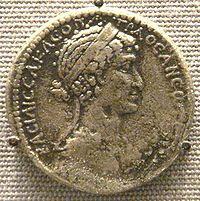
At the Donations of Alexandria in late 34 BC, following Antony's conquest of Armenia, Cleopatra and Caesarion were crowned co-rulers of Egypt and Cyprus; Alexander Helios was crowned ruler of Armenia, Media, and Parthia; Cleopatra Selene II was crowned ruler of Cyrenaica and Libya; and Ptolemy Philadelphus was crowned ruler of Phoenicia, Syria, and Cilicia. Cleopatra was also given the title of "Queen of Kings" by Antonius. Her enemies in Rome feared that Cleopatra, "...was planning a war of revenge that was to array all the East against Rome, establish herself as empress of the world at Rome, cast justice from Capitolium, and inaugurate a new universal kingdom." Caesarion was not only elevated having coregency with Cleopatra, but also proclaimed with many titles, including god,son of god and king of kings, and was depicted as Horus. Egyptians thought Cleopatra was a reincarnation of the goddess Isis, as she called herself Nea Isis.
Relations between Antony and Octavian, disintegrating for several years, finally broke down in 33 BC, and Octavian convinced the Senate to levy war against Egypt. In 31 BC Antony's forces faced the Romans in a naval action off the coast of Actium. Cleopatra was present with a fleet of her own. According to Plutarch, Cleopatra took flight with her ships at the height of the battle and Antony followed her. Following the Battle of Actium, Octavian invaded Egypt. As he approached Alexandria, Antony's armies deserted to Octavian on August 1, 30 BC.
There are a number of unverifiable stories about Cleopatra, of which one of the best known is that, at one of the lavish dinners she shared with Antony, she playfully bet him that she could spend ten million sestertii on a dinner. He accepted the bet. The next night, she had a conventional, unspectacular meal served; he was ridiculing this, when she ordered the second course — only a cup of strong vinegar. She then removed one of her priceless pearl earrings, dropped it into the vinegar, allowed it to dissolve, and drank the mixture. The earliest report of this story comes from Pliny the Elder and dates to about 100 years after the banquet described would have happened. The calcium carbonate in pearls does dissolve in vinegar, but slowly unless the pearl is first crushed.
Death
The ancient sources, particularly the Roman ones, are in general agreement that Cleopatra killed herself by inducing an Egyptian cobra to bite her. The oldest source is Strabo, who was alive at the time of the event, and might even have been in Alexandria. He says that there are two stories: that she applied a toxic ointment, or that she was bitten by an asp on her breast. Several Roman poets, writing within ten years of the event, all mention bites by two asps, as does Florus, a historian, some 150 years later. Velleius, sixty years after the event, also refers to an asp. Other authors have questioned these historical accounts, stating that it is possible that Augustus had her killed. In 2010, the German historian Christoph Schaefer challenged all other theories, declaring that the queen had actually been poisoned and died from drinking a mixture of poisons. After studying historical texts and consulting with toxicologists, the historian concluded that the asp could not have caused a slow and pain-free death, since the asp ( Egyptian cobra) venom paralyses parts of the body, starting with the eyes, before causing death. Schaefer and his toxicologist Dietrich Mebs decided Cleopatra used a mixture of hemlock, wolfsbane and opium.
Plutarch, writing about 130 years after the event, reports that Octavian succeeded in capturing Cleopatra in her mausoleum after the death of Antony. He ordered his freedman Epaphroditus to guard her to prevent her from committing suicide, because he allegedly wanted to present her in his triumph. But Cleopatra was able to deceive Epaphroditus and kill herself nevertheless. Plutarch states that she was found dead, her handmaiden Iras dying at her feet, and another handmaiden, Charmion, adjusting her crown before she herself fell. He then goes on to state that an asp was concealed in a basket of figs that was brought to her by a rustic, and, finding it after eating a few figs, she held out her arm for it to bite. Other stories state that it was hidden in a vase, and that she poked it with a spindle until it got angry enough to bite her on the arm. Finally, he indicates that in Octavian's triumphal march back in Rome, an effigy of Cleopatra that had an asp clinging to it was part of the parade.
Suetonius, writing about the same time as Plutarch, also says Cleopatra died from an asp bite.
Shakespeare re-introduced part of the image, Cleopatra clutching the snake to her breast. Before him, it was generally agreed that she was bitten on the arm.
Plutarch tells us of the death of Antony. When his armies deserted him and joined with Octavian, he cried out that Cleopatra had betrayed him. She, fearing his wrath, locked herself in her monument with only her two handmaidens and sent messengers to tell Antony that she was dead. Believing them, Antony stabbed himself in the stomach with his sword, and lay on his couch to die. Instead, the blood flow stopped, and he begged any and all to finish him off. Another messenger came from Cleopatra with instructions to bring him to her, and he, rejoicing that Cleopatra was still alive, consented. She wouldn't open the door, but tossed ropes out of a window. After Antony was securely trussed up, she and her handmaidens hauled him up into the monument. This nearly finished him off. After dragging him in through the window, they laid him on a couch. Cleopatra tore off her clothes and covered him with them. She raved and cried, beat her breasts and engaged in self-mutilation. Antony told her to calm down, asked for a glass of wine, and died upon finishing it.
The site of their mausoleum is uncertain, though the Egyptian Antiquities Service believes it is in or near the temple of Taposiris Magna, southwest of Alexandria.
Cleopatra's son by Caesar, Caesarion, was proclaimed pharaoh by the Egyptians, after Alexandria fell to Octavian. Caesarion was captured and killed, his fate reportedly sealed when one of Octavian's advisers paraphrased Homer: "It is bad to have too many Caesars." This ended not just the Hellenistic line of Egyptian pharaohs, but the line of all Egyptian pharaohs. The three children of Cleopatra and Antony were spared and taken back to Rome where they were taken care of by Antony's wife, Octavia Minor. The daughter, Cleopatra Selene, was married through arrangements of Octavian to Juba II of Mauretania.
Character and cultural depictions
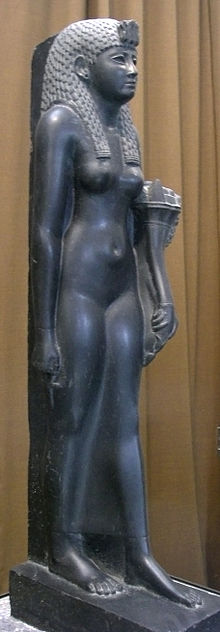
Cleopatra was regarded as a great beauty, even in the ancient world. In his Life of Antony, Plutarch remarks that "judging by the proofs which she had had before this of the effect of her beauty upon Caius Caesar and Gnaeus the son of Pompey, she had hopes that she would more easily bring Antony to her feet. For Caesar and Pompey had known her when she was still a girl and inexperienced in affairs, but she was going to visit Antony at the very time when women have the most brilliant beauty." Later in the work, however, Plutarch indicates that "her beauty, as we are told, was in itself neither altogether incomparable, nor such as to strike those who saw her." Rather, what ultimately made Cleopatra attractive were her wit, charm and "sweetness in the tones of her voice."
Cassius Dio also spoke of Cleopatra's allure: "For she was a woman of surpassing beauty, and at that time, when she was in the prime of her youth, she was most striking; she also possessed a most charming voice and knowledge of how to make herself agreeable to everyone. Being brilliant to look upon and to listen to, with the power to subjugate everyone, even a love-sated man already past his prime, she thought that it would be in keeping with her role to meet Caesar, and she reposed in her beauty all her claims to the throne."
These accounts influenced later cultural depictions of Cleopatra, which typically present her using her charms to influence the most powerful men in the Western world.
Ancestry
The high degree of inbreeding amongst the Ptolemies is also evident when one considers Cleopatra's immediate family. Her father was likely the uncle of Cleopatra's mother. There were three uncle/niece and three brother/sister relationships in her ancestry going back to a single set of either great grandparents or great great grandparents, depending on how the ancestry is traced. The relatively small number of ancestors can be seen from the possible ancestry of Cleopatra VII as shown below.
|
|
Ptolemy V Epiphanes |
|
|
|
Cleopatra I of Egypt | ||||||||||||||||||||||||||||||||||
|
|
|
|
|
||||||||||||||||||||||||||||||||||||
|
|
|
|
|
|
|
|
|
|
|
|
|
|
|
|
|
|
|
||||||||||||||||||||||
|
|
|
|
|
|
|
|
|
|
|
|
|
|
|
||||||||||||||||||||||||||
|
|
|
Ptolemy VIII Physcon |
|
|
|
Ptolemy VI Philometor |
|
|
|
Cleopatra II of Egypt | |||||||||||||||||||||||||||||
|
|
|
|
|
|
|||||||||||||||||||||||||||||||||||
|
|
|
|
|
|
|
|
|
|
|
|
|
|
|
||||||||||||||||||||||||||
|
|
|
|
|
|
|
|
|
|
|
|
Cleopatra III of Egypt | ||||||||||||||||||||||||||||
|
|
|
|
|
|
|
||||||||||||||||||||||||||||||||||
|
|
|
|
|
|
|
|
|
|
|
|
|
|
|
|
|
|
|
|
|
|
|
|
|||||||||||||||||
|
|
|
|
|
|
|
|
|
|
|
|
|
|
|
|
|
|
|
|
|
||||||||||||||||||||
| Ptolemy X Alexander I |
|
|
|
Cleopatra Selene I |
|
|
|
Ptolemy IX Lathyros |
|
|
|
Cleopatra IV of Egypt | |||||||||||||||||||||||||||
|
|
|
|
|
|
|
|
|
|
|||||||||||||||||||||||||||||||
|
|
|
|
|
|
|
|
|
|
|
|
|
|
|
|
|
|
|
|
|||||||||||||||||||||
|
|
|
|
|
|
|
|
|
|
Berenice III of Egypt |
|
|
|
|
Ptolemy XII Auletes | |||||||||||||||||||||||||
|
|
|
|
|
|
|
|
|
||||||||||||||||||||||||||||||||
|
|
|
|
|
|
|
|
|
|
|
|
|
|
|
|
|
||||||||||||||||||||||||
|
|
|
|
|
|
Cleopatra V of Egypt |
|
|
|
|
|
|
|
|||||||||||||||||||||||||||
|
|
|
|
|
|
|
|
|||||||||||||||||||||||||||||||||
|
|
|
|
|
|
|
|
|
|
Cleopatra VII | ||||||||||||||||||||||||||||||
![N29 [q] q](../../images/1670/167096.png)
![E23 [rw] rw](../../images/1670/167097.png)
![M17 [i] i](../../images/1670/167098.png)
![V4 [wA] wA](../../images/1670/167099.png)
![Q3 [p] p](../../images/1671/167100.png)
![G1 [A] A](../../images/1671/167101.png)
![D46 [d] d](../../images/1452/145261.png)
![D21 [r] r](../../images/1407/140750.png)
![X1 [t] t](../../images/1407/140755.png)


![G36 [wr] wr](../../images/1671/167109.png)
![V30 [nb] nb](../../images/1671/167110.png)
![F35 [nfr] nfr](../../images/1671/167111.png)

![Aa1 [x] x](../../images/1671/167113.png)


![Z7 [W] W](../../images/1671/167121.png)

![N35 [n] n](../../images/1407/140752.png)

![O34 [z] z](../../images/1452/145260.png)
![R8 [nTr] nTr](../../images/1671/167124.png)


